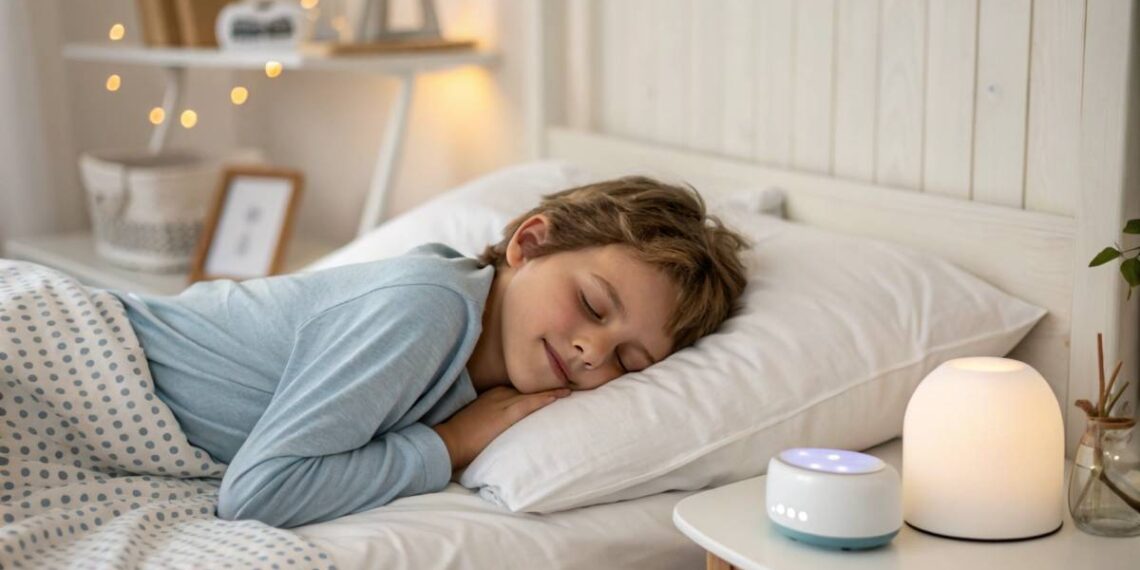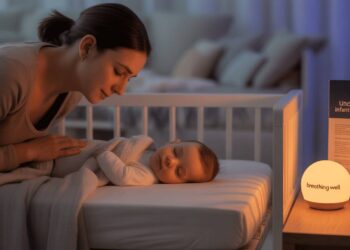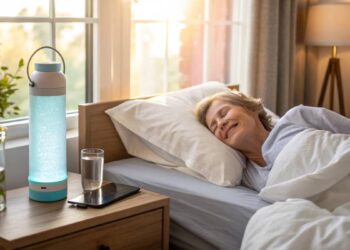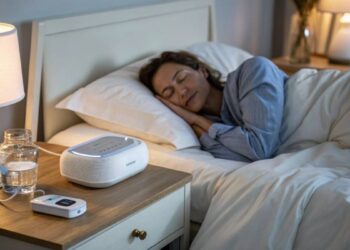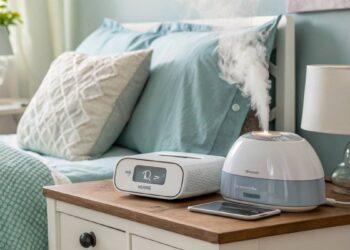Is your child waking up restless or struggling to breathe during sleep? Pediatric sleep apnea might be the culprit disrupting their nights and daily lives. This condition, characterized by irregular breathing patterns, can significantly impact a child’s health, growth, and behavior. Understanding the signs and acting swiftly is essential for ensuring your child’s well-being. In this guide, we delve into the symptoms, risk factors, and effective treatments for pediatric sleep apnea, empowering parents to take proactive steps towards their child’s restful and healthy sleep.
Key Takeaways
- Recognize Symptoms Early: Loud snoring, breathing pauses, restless sleep, and bedwetting are key indicators of pediatric sleep apnea.
- Understand Risk Factors: Excess weight, large tonsils, family history, and unique facial structures increase the likelihood of sleep apnea in children.
- Importance of Early Detection: Early identification and treatment can prevent complications like mood swings, stunted growth, and heart concerns.
- Comprehensive Diagnosis and Treatment: Consulting pediatric sleep specialists and undergoing sleep studies are crucial steps in managing sleep apnea.
- Lifestyle and Environmental Changes: Weight management, establishing a positive sleep routine, and creating a supportive sleep environment can alleviate symptoms.
- Ongoing Monitoring and Support: Regular check-ups and treatment adjustments ensure effective management and improved quality of life for affected children.
Unveiling Pediatric Sleep Apnea
What is Pediatric Sleep Apnea?
Pediatric sleep apnea is when kids have trouble breathing normally while catching those Z’s. It’s like their airways play peek-a-boo, which isn’t as fun as it sounds. This condition can mess with a kid’s health, growth, and even how they behave. Often, it’s due to a blockage in the airway. Kids with this might sound like a little sawmill at night, with snoring, gasping, and breath-pauses. If you ever found yourself saying, “That doesn’t seem right,” about your child’s sleep habits, this could be why.
“Understanding the intricacies of pediatric sleep apnea is the first step towards ensuring our children grow up healthy and well-rested.” – Dr. Emily Harper, Pediatric Sleep Specialist
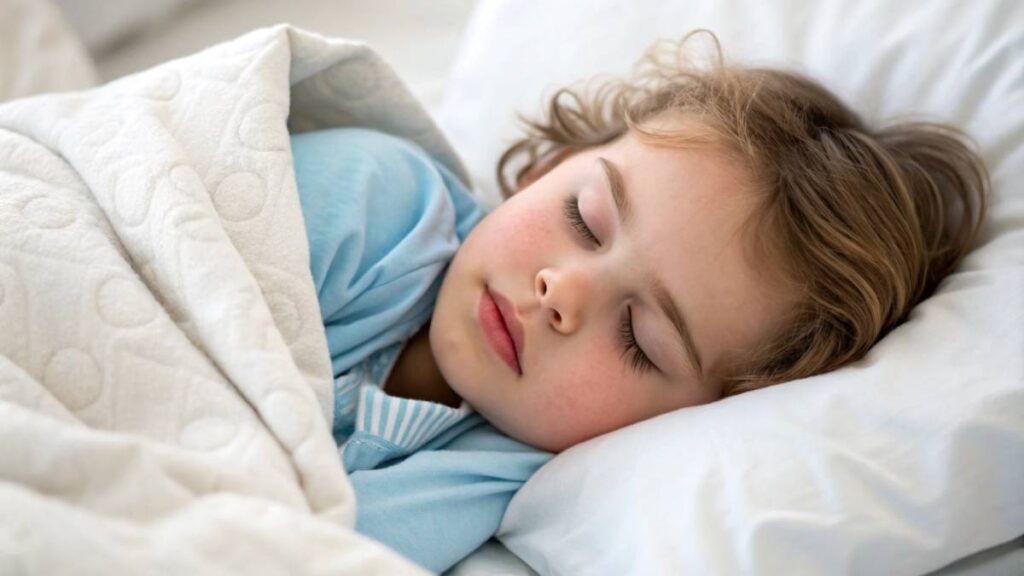
Why Early Detection is Crucial
You can take a cue from those early bird gets the worm sayings when it comes to spotting this sleep apnea beast. Catching it early means you can dodge a bunch of problems tied to missed Z’s. If sleep apnea goes unchecked, here’s the kind of trouble it stirs:
| Complication | How It Messes Things Up |
|---|---|
| Mood Swings and Focus | Trouble concentrating and getting cranky at school |
| Stunted Growth | Growth doesn’t exactly follow the script |
| Heart Concerns | Could lead to high blood pressure or heart worries |
Getting on top of sleep apnea sooner rather than later gives your child a smoother ride through treatment, sleep, and life. Moms and dads, listen up: keep yourself in the know and reach out to doctors if you think sleep apnea is crashing the party at night. For more signs to watch out for, check what sleep apnea symptoms usually pop up.
Symptoms to Watch For
Catching onto signs of sleep apnea in kiddos early is a big help for parents. Spotting the symptoms early means getting help quicker. Here’s what to look out for:
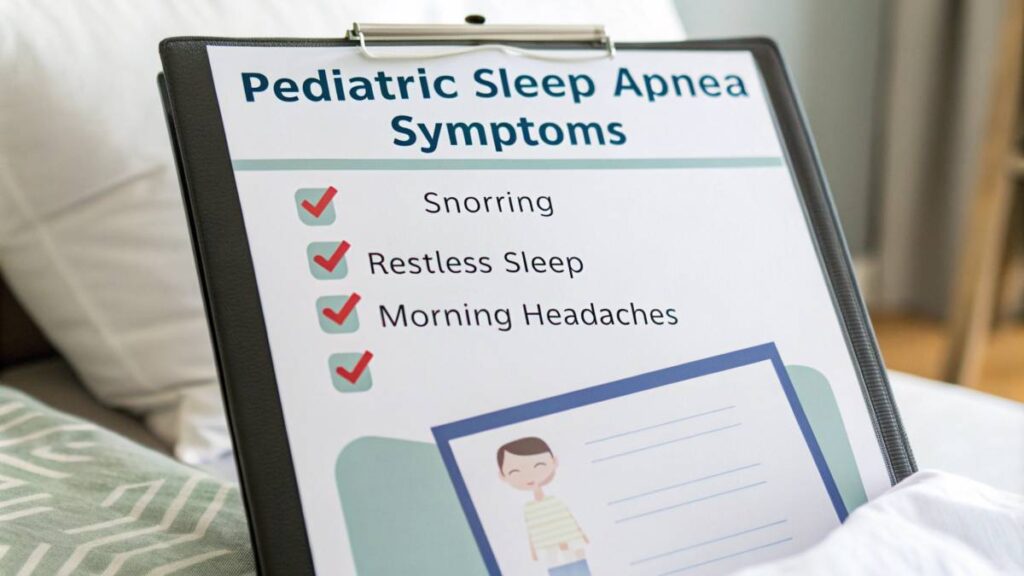
Loud Snoring and Breathing Pauses
One big clue of sleep apnea in kids is a snore that could wake the neighbors—paired with noticeable pauses in their breathing. During these moments, it might seem like they’re trying to catch a breath.
| Symptom | Description |
|---|---|
| Loud Snoring | A heavy snore that persists through the night. |
| Breathing Pauses | Pauses in breathing that stretch longer than usual. |
If your kid’s a noisemaker at night or holds their breath a lot while sleeping, it might be time to chat with a doc. These could come along with other sleep apnea signs.
Restless Sleep and Bedwetting
Another hint at sleep apnea is tossing and turning like they’re sleeping on a trampoline. They’ll move around a bunch, wake up a lot, or feel like a zombie the next day. Bedwetting might pop up again, even in kids who’d moved on from it.
| Symptom | Description |
|---|---|
| Restless Sleep | Nighttime fidgeting or sleep disruptions. |
| Bedwetting | Going back to bedwetting after having outgrown it before. |
If you’re catching these patterns, maybe it’s time for a doc visit to see what’s up, including reasons for sleep apnea.
Morning Headaches and Daytime Fatigue
Some kiddos with sleep apnea wake up with headaches and feel like they’ve drifted through the day on a raft of fatigue. Those headaches might chill out as the day rolls on. Fatigue during the day might mean crankiness, trouble focusing, or bouncing off the walls.
| Symptom | Description |
|---|---|
| Morning Headaches | Wake-up headaches that ease up later. |
| Daytime Fatigue | Feeling worn out or sleepy all day. |
Keeping tabs on these signs boosts chances of figuring out sleep apnea in kids. If your child shows these symptoms, a visit to a sleep expert for kids could offer some answers. For more deets on telling apart types of sleep apnea, check out central vs obstructive sleep apnea.
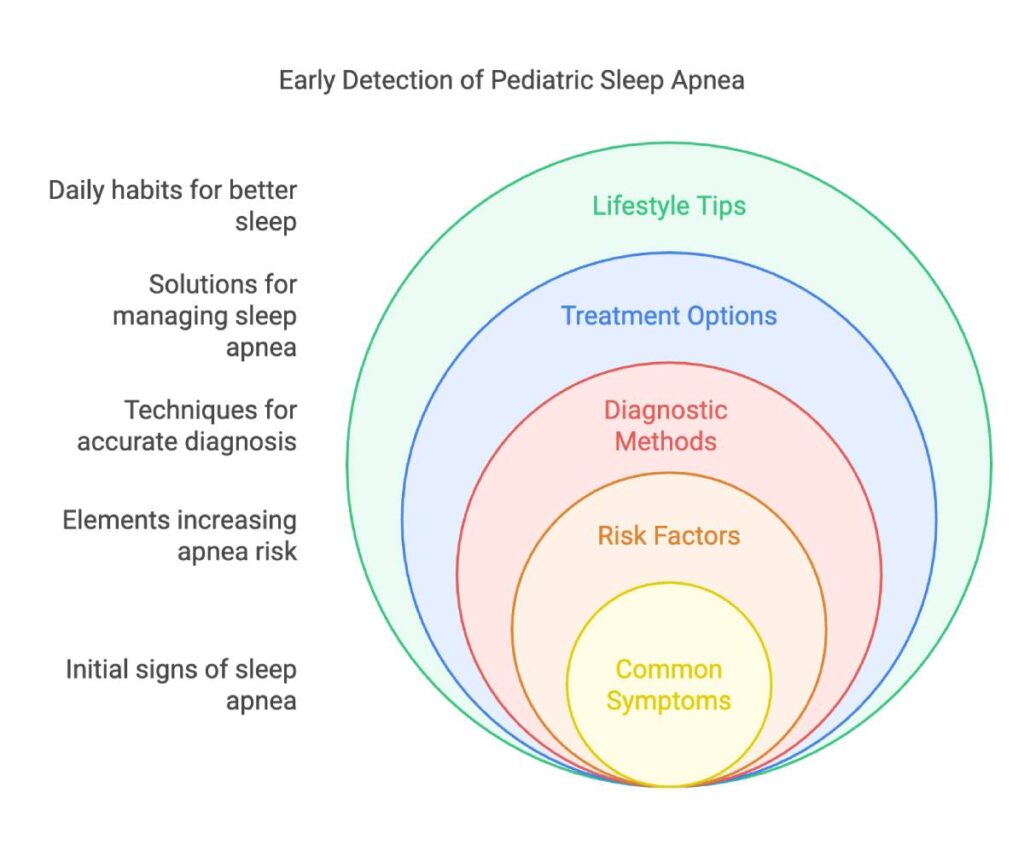
Risk Factors and Causes
Nobody wants their kiddo struggling with sleep, right? So, let’s get down to the nitty-gritty of what can cause sleep apnea in little ones. Spotting the signs early can make all the difference! Let’s see what might be lurking around, causing nighttime mischief.
Chubby Cheeks and Big Tonsils
First up, carrying a bit more weight can be a real snooze-snatcher. Those extra pounds might pack a pillow around the neck, blocking the flow of air like an unwanted sandman. Kids with a little more bounce might find their breath playing hide-and-seek when it’s time to hit the hay.
And those darn tonsils and adenoids? Well, if they’re a bit on the large side, they’re just waiting to play bouncer in the airway club. Lying down lets them really get in the way, cutting off breaths left and right.
| Risk Factor | Sleepy-Time Mischief |
|---|---|
| Extra Pounds | Airway blockage invites breathing issues |
| Big Tonsils | Block air when kids are catching Z’s |
Family Ties and Funky Faces
Guess what? If there’s a history of sawing logs loudly (like, seriously loud) in the family, your young one might hitch a ride on that train. It’s like a genetic sleepover where nobody really sleeps.
Then there’s the whole craniofacial lineup. Some kids might come into the world with a few unique facial structures, like narrow jaws or quirky face shapes. These can give the airway a squeeze, making life a bit harder for those sweet dreams.
| Risk Factor | Sleepy-Time Mischief |
|---|---|
| Family Snoring Lineage | More likely to encounter sleep issues |
| Quirky Face Shapes | Easier for airways to get blocked |
Knowing what to look out for means you’re partway to solving the puzzle of your child’s sleep woes. Need more clues? Check out our scoop on sleep apnea symptoms and peek into the world of what causes sleep apnea. Keeping a watchful eye could be the first step in giving your kid a peaceful night’s rest without the obstacles.
Diagnosis and Treatment
Spotting and tackling sleep apnea in kids is a big deal for their health and growth. Getting to the bottom of it usually means a few key steps, like consulting with experts and digging into detailed sleep studies.
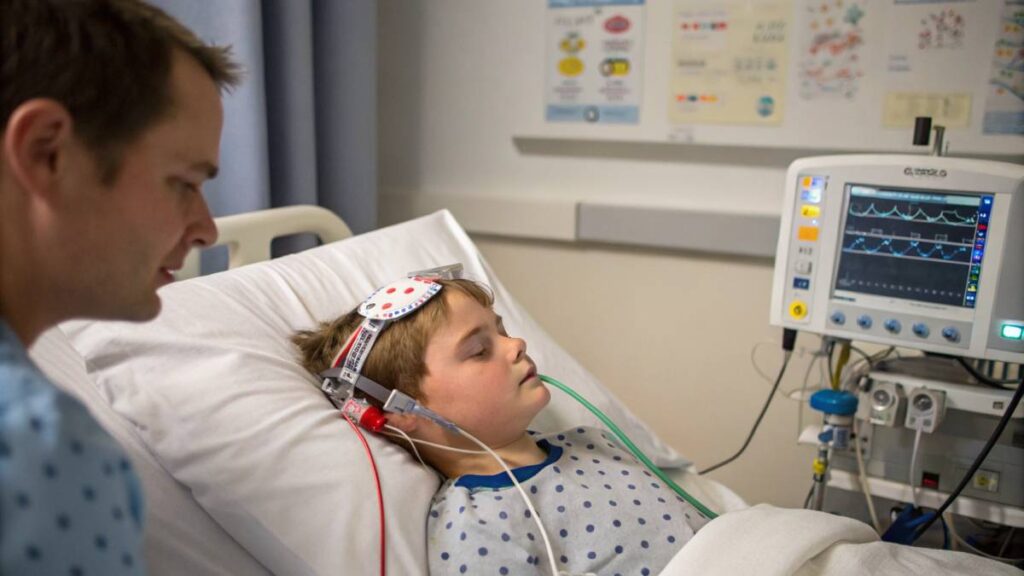
Consulting a Pediatric Sleep Specialist
First off, parents should get in touch with a pediatric sleep specialist. This expert knows all the ins and outs of kids’ sleep troubles and can offer a heads-up on what might be going wrong. During this meet-up, they’ll take a look at the child’s history, parental notes, and any nagging concerns about their sleep habits.
If the little one is noisy in their sleep, tosses and turns, or seems wiped out during the day, a good once-over from the specialist can be a game-changer. They’ll walk parents through what’s going on with their kid’s sleep and the treatment routes available.
Sleep Studies and Monitoring
After sizing things up, the specialist might suggest a sleep study to get a closer look at the child’s snooze patterns and any breathing hiccups. Sometimes these studies happen at a clinic, but doing them at home could work too, depending on what’s handy.
Here’s a quick look at the common sleep study tests:
| Test Type | Description |
|---|---|
| Polysomnography | Full-blown overnight test that checks brain waves, oxygen levels, heart rate, and breathing. |
| Home Sleep Apnea Test | An easier test that tracks breathing at home, usually less bothersome. |
These tests dish out vital info that helps nail down what’s causing the sleep apnea, be it central or obstructive. For the lowdown on these types, check out our article on central vs obstructive sleep apnea.
Once they’ve got answers, the game plan might involve switching up daily habits, using mouth gear, or trying CPAP therapy. If the kid’s not into CPAP, chatting about alternatives to CPAP with the specialist could be a plus.
It’s like this: catching things early and jumping in makes a huge difference when dealing with sleep apnea in kids. Parents should keep an eye on their kid’s sleep patterns and give a nod to specialists if anything seems off. For more details on what to watch for, head over to our section on sleep apnea symptoms.
Lifestyle Changes and Support
Making some changes in your day-to-day routine can really help when it comes to dealing with pediatric sleep apnea. Tweaking how we eat and sleep can make a huge difference for little ones facing these challenges.
“Small, consistent changes in a child’s routine can lead to significant improvements in managing sleep apnea and enhancing their overall quality of life.” – Michael Thompson, Child Wellness Coach
Weight Management for Overweight Children
Extra weight can make snoring a bigger nightmare for kids. Helping a child trim down can sometimes wipe out sleep apnea altogether. Here’s some food for thought:
| Game Plan | What’s Cookin’? |
|---|---|
| Well-Balanced Meals | Think colorful plates: load up on fruits, veggies, whole grains, and lean meats, while putting the brakes on junk food. |
| Get Moving! | Encourage at least an hour of active fun or exercise most days. Unleash those playful spirits! |
| Family Fun Time | Make healthy choices a family affair and lead by example. It’s easier when everyone’s in it together! |
Parents can keep tabs using a simple notebook to jot down meals, activities, and weigh-ins. For a deeper look into weight loss and snoring fixes, check does weight loss help sleep apnea.
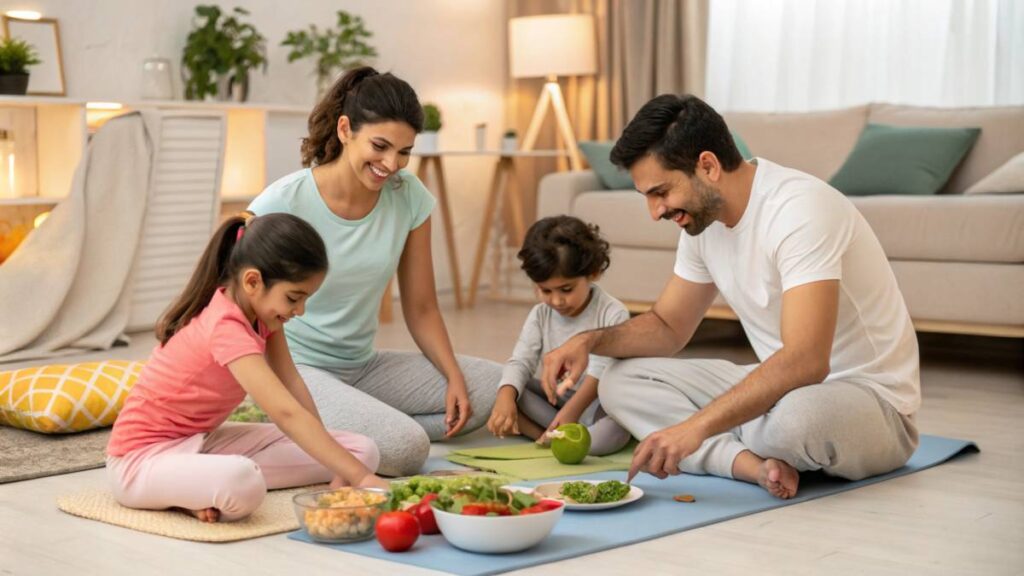
Positive Sleep Environment and Routine Development
A supportive snooze-zone is key for young ones with sleep apnea. Here’s a simple checklist:
| Cozy Tips | How-To |
|---|---|
| School Night Schedule | Set a regular sleep and wake time—it helps kick out chaos in those z’s. |
| The Sleep Sanctuary | Make the room cool, dark, and noiseless—a total chill-out zone. |
| Pre-Bed Chillax Time | Low-key activities like reading or a warm bath can let the body know it’s bedtime. |
Sticking to these steps can lead to more peaceful slumbers. A pre-sleep ritual might just lower those bothersome sleep apnea symptoms.
Bring together a healthy eating plan and a cozy sleep haven. It won’t just improve nightly rest but also boost overall happiness and health for kids dealing with sleep apnea. For more on what’s shaking things up with sleep apnea, check what causes sleep apnea.
Monitoring and Follow-Up
Keeping tabs on sleep apnea in kiddos isn’t just a one-and-done deal. Regular check-ups and a bit of sleuthing help in managing those pesky symptoms and tweaking treatments when things aren’t hitting the mark.
Importance of Regular Check-Ins
Consistent visits to the doctor’s office for kids with sleep apnea aren’t just another appointment on the calendar; they’re a must. These check-ins let healthcare professionals take a good ol’ look at how the child is doing. They make sure symptoms aren’t crashing the party and everything’s on an upward swing, swooping in with solutions if things start to slide.
These sessions are also a golden opportunity for parents to chat about any tweaks in their kiddo’s sleep, shifts in behavior, or new issues cropping up, like a new guest at the health table. Having these heart-to-hearts means that any changes in treatment are spot on, keeping parents in the loop about how their little one’s doing.
Adjusting Treatments as Needed
Kids are always growing and changing, so it makes sense that their sleep apnea treatment might need to flex a bit, too. Docs might swap things up depending on how well treatments are working and if there are new sleep hurdles to jump over. Here’s how they might shuffle things around:
| Treatment Change | What Might Happen |
|---|---|
| CPAP Settings | Turning the pressure up or down |
| Weight Management Tricks | Rethinking meal plans or mixing up workouts |
| Trying Something New | Checking out stuff like natural fixes for sleep apnea or exercises for sleep apnea |
| Surgery Talk | Looking at options like sleep apnea surgery |
Parents who keep the conversation open with doctors and get involved in the process are unsung heroes in their child’s health story. These regular check-ins and treatment tweaks don’t just aim for better sleep—they shoot for an overall boost in their kid’s life quality.
Main Tips
- Monitor Sleep Patterns: Keep an eye on your child’s sleep behaviors, noting any irregularities or signs of distress.
- Maintain Healthy Weight: Encourage a balanced diet and regular physical activity to help manage your child’s weight effectively.
- Create a Consistent Sleep Routine: Establish regular bedtime and wake-up times to promote better sleep quality.
- Consult Specialists Early: Don’t hesitate to seek professional advice if you suspect your child has sleep apnea.
- Use Supportive Sleep Accessories: Invest in appropriate pillows and bedding that support proper airway alignment during sleep.
- Limit Screen Time Before Bed: Reduce exposure to screens in the evening to help your child unwind and prepare for restful sleep.
- Encourage Relaxation Techniques: Promote activities like reading or gentle stretching before bed to enhance relaxation.
Final Thoughts
Addressing pediatric sleep apnea is a journey that demands awareness, timely intervention, and sustained support. As parents, recognizing the early signs and understanding the underlying causes can make a profound difference in your child’s health and happiness. Collaborating with healthcare professionals ensures that your child receives the necessary treatments tailored to their unique needs, fostering better sleep and overall well-being. Additionally, integrating lifestyle changes and creating a nurturing sleep environment not only mitigates sleep apnea symptoms but also promotes healthy habits that benefit your child in the long run. Remember, every small step you take towards improving your child’s sleep quality contributes to their growth, emotional stability, and academic performance. Stay informed, stay proactive, and prioritize your child’s sleep health to unlock a brighter, more energetic future for them.
Conclusion
Ensuring your child enjoys restful and uninterrupted sleep is pivotal for their overall growth and development. Pediatric sleep apnea, though challenging, can be effectively managed with early detection and the right interventions. By staying vigilant and recognizing symptoms like loud snoring, restless sleep, and daytime fatigue, parents can seek timely medical advice and initiate appropriate treatments. Collaborating with pediatric sleep specialists to undergo thorough sleep studies provides a clear roadmap for addressing the condition. Moreover, implementing lifestyle changes such as weight management and fostering a positive sleep environment can significantly reduce sleep apnea symptoms. Continuous monitoring and regular follow-ups with healthcare professionals ensure that the treatment remains effective as your child grows and their needs evolve. Remember, proactive steps today can pave the way for healthier nights and brighter days for your child. Prioritize their sleep health now to support their physical and emotional well-being for years to come.
FAQs
What are the common symptoms of pediatric sleep apnea?
Common symptoms include loud snoring, breathing pauses during sleep, restless sleep, bedwetting, morning headaches, and daytime fatigue or irritability.
What causes sleep apnea in children?
Sleep apnea in children is often caused by enlarged tonsils and adenoids, excess weight, family history, and certain craniofacial abnormalities that obstruct the airway.
How is pediatric sleep apnea diagnosed?
Diagnosis typically involves consulting a pediatric sleep specialist and undergoing sleep studies such as polysomnography or a home sleep apnea test to monitor breathing patterns and other vital signs during sleep.
What treatments are available for pediatric sleep apnea?
Treatments include surgical removal of tonsils and adenoids, using CPAP machines, oral appliances, weight management, and making lifestyle and environmental changes to improve sleep quality.
Why is early detection of sleep apnea important for children?
Early detection helps prevent complications like mood swings, impaired concentration, stunted growth, and heart issues, ensuring better health and development for the child.

